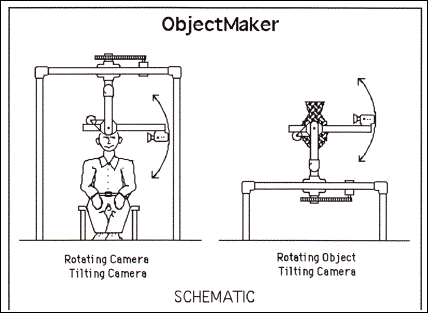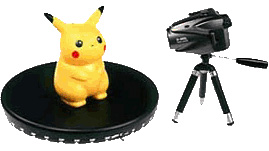Multimedia artists strive to create fresh and unique experiences. These artist-designed experiences must draw viewers in and force them to take notice – to feel something. Sometimes new ideas for effective art come from old technology.
This article examines how one artist may have redefined how 360-degree photography can be used in art, motion graphics, and film.
Reclaiming 360-degree photography effects for art

Ryan Enn Hughes is bringing a fresh perspective to a motion graphic gimmick representative of 1990s-flavored multimedia excess: the 360-degree spin effect.
By using an array of still cameras, Hughes captured 360-degree photographs of dancers frozen in visually dynamic poses. These photographs were then paired with sound and motion graphics to create a stunning remix.
The 360 Project by Ryan Enn Hughes
Ryan Enn Hughes is a Motion Picture Director and Portrait Photographer. Hughes’s 360 Project includes Krump 360 and Ballet 360. Huges describes his work as follows:
“The 360 Project” is an exploration into the crossroads of photography and motion pictures. It is a study of peak dance movements, captured simultaneously by 48 cameras aligned in a circle.
There are two components to “The 360 Project” – “Ballet 360” features ballerinas from Canada’s National Ballet School, “Krump 360” features dancers from Northbuck Krump. The two styles of dance represent polemic perspectives in both technique and origin – one is beauty, the other beast.
The resulting images resemble a type of digital statue – a frozen, peak moment, embodying the essence of each dance form in 360 degrees.
Ballet 360
Krump 360
Behind the Scenes of the 360 Project
What is 360-degree photography?
360-degree multimedia photography makes two experiences possible:
- Exploration of a place by viewing panoramic photography
- Exploration of objects through images taken at multiple viewing angles
Ryan Enn Hughes’ work is a variation on the second type of 360-degree photography: the photography of a stationary object from multiple sides in order to create the illusion of spinning the object. The effect is also known as rotary view, 360-degree object photography, and product spin.
The origins of 360-degree photography & multimedia technology
Ryan Enn Hughes’ work, whether he realizes it or not, was inspired and affected by nearly four decades of research and development. The technology that makes 360-degree photography and multimedia possible was contributed to by the inventions of John Borden, research at MIT, and software development at Apple Computer.
The invention of gyrostabilizers
John Borden founded Peace River Films in 1972 where he designed gyrostabilizers in order to film the behavior of wolves from a fixed-wing bush plane (Bienias, 2011).
Seeds of interactivity: The Aspen Movie Map
In 1979, Borden worked with an MIT research team to create a gyro camera stabilization system used to capture imagery for the Aspen Movie Map – a hyper media system that presented a virtual tour of the city of Aspen, Colorado, USA (Wikipedia, 2011). In a VRmag.org interview, Borden indicated that one member of the MIT Aspen Movie Map research team went on to work at Apple Computer (Bienias, 2011).
The birth of QuickTime VR and mainstream 360-degree photo tools
In the early 1990s, Borden was commissioned to design and construct an “ObjectMaker” by Apple Computer’s Human Interface Group (O’Sullivan, 1992). Borden and his team began the design of a computer-controlled camera system able to capture photographic arrays of 3-D objects for display and interaction as virtual objects (Bienias, 2011). The device was paired with software written by Apple Computer’s Dan O’Sullivan and was used to digitize a physical object from multiple angles (O’Sullivan, 1992). A series of 360-degree photo tests of Pavlovsk Palace, Golden Gate, Dan O’Sullivan’s apartment, Paris, and an interactive Aeron Chair photograph, may be viewed by visiting Dan O’Sullivan’s blog.

In 1994, John formed Peace River Studios and released the ObjectMaker Camera Positioning System and the 3Sixty Panoramic Camera Mount (Bienias, 2011). That same year, Apple released QuickTime VR for sale at a price of US$2,000 (Wikipedia, 2011 and Nemeth, 1996).
In 1995, Kaidan Incorporated was founded and began to sell manual turntables and photographic accessories that assisted with the creation of 360-degree photographs using both QuickTime VR and Kaidan’s proprietary software (Kaidan, 2008).

360-degree photography in popular culture
QuickTime VR and the O.J. Simpson murder trial
The use of 360-degree photography and multimedia was brought to national attention in the United States when QuickTime VR was used by NBC in 1995 to reconstruct Nicole Simpson’s condo as part of their coverage of the O.J. Simpson murder trial (Abate, 1995).
360-degree photos and web-based product demonstrations
Throughout the mid-90s, Apple used QuickTime VR to offer interactive 360-degree product demonstrations of their iMacs and iPods. Apple also partnered with BMW to present a 360-degree motion VR marketing piece for the BMW Z3 – a series of short films were also paired with the VR content and presented via the “bmwfilms” website. The application of 360-degree photographs for product photography was extended to numerous eCommerce websites.
The Matrix and “Bullet-time”
The 360-degree spin effect was used in a feature-length film in 1999 with the release of The Matrix. The “Bullet-time” sequence in The Matrix was created by visual effects supervisor John Gaeta using an array of 120 still cameras and two motion cameras. In addition to viewing subjects from 360-degree angles, the speed and pace of the footage is modified for effect. The special effects shot for “Bullet-time” was not created using QuickTime – however, the techniques for staging the shot were similar to those pioneered by John Borden and Apple.
The 360-degree spin effect reaches the masses through t.v. advertising
Later, use of the 360-degree spinning effect became commonplace and was applied to objects and 3D text in product advertisements targeted for television audiences.
Closing thoughts on the 360-degree spin effect
The 360 Project that Hughes has created brings a new perspective on a special effect that was once perceived as amazing and innovative and eventually fell out of favor and became a cliché. Perhaps we no longer need to shun the 360-degree spin effect?
After viewing these videos, what do you think? Has Hughes redeemed the 360-degree spin?
References
Wikipedia. (2011). Aspen Movie Map. Retrieved October 3, 2011 from http://en.wikipedia.org/wiki/Aspen_Movie_Map.
Bienias, M. (2011). An Interview with Peace River Studios. Retrieved October 3, 2011 from http://www.vrmag.org/vartist/community/AN_INTERVIEW_WITH_PEACE_RIVER_STUDIOS.html.
O’Sullivan, D. (1992). Object Maker. Retrieved October 3, 2011 from https://itp.nyu.edu/~dbo3/blog/object-maker/.
Wikipedia. (2011). QuickTime VR. Retrieved October 3, 2011 from https://en.wikipedia.org/wiki/Quicktime_vr.
Abate, T. (1995). NBC gets “real” for O.J. trial TV viewers to see virtual reality images. Retrieved October 3, 2011 from https://www.sfgate.com/news/article/NBC-gets-real-for-O-J-trial-3152186.php.
Nemeth, A. (1996). Getting started with Quicktime VR. Retrieved October 3, 2011 from http://www.nemeng.com/history/1996qtvr.pdf.
Kaidan. (2008). Kaidan Incorporated. Retrieved October 3, 2011 from http://www.kaidan.com/.
